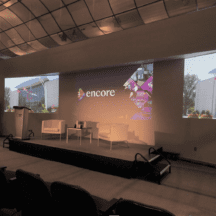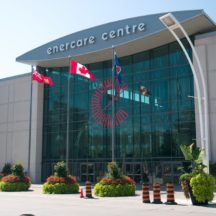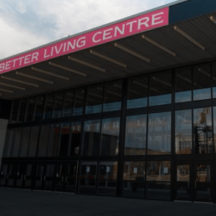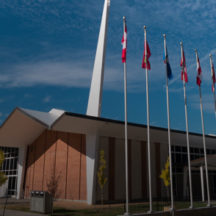Self-guided walking tours
Here you will find all you need for self-guided walking tours across our grounds. After locating the desired landmark, you can download and print the map and walk details. Download the Story City App and follow along on the walking tours!
Approximate time to complete
- Cycling: N/A
- Walking: 20 Minutes
- Driving: N/A
Approximate distance
- 1 km
Known as The Garden of the Greek Gods, the works were created by the late Toronto artist Elford Bradley Cox (1914-2003).
Cox carved the sculptures from huge blocks of limestone, using an air hammer and chisels. Among them are Medusa, Pan, Orpheus, Centaur, Minotaur, and many more.
The Garden of the Greek Gods opened to the public on November 9, 2022. HeARTLab’s Digital Amphitheatre can be accessed by visiting digitalamphitheatre.com.
Garden of the Greek Gods Location Map
view and downloadApproximate time to complete
- Cycling: 1 hour
- Walking: 2 hours
- Driving: 30 minutes
Approximate distance
- 5 km
Most of the grounds are paved or have sidewalks, making access possible by foot, bicycle, wheelchair, or vehicle.
Walking Tour Map
view and downloadApproximate time to complete
- Cycling: 1 hour
- Walking: 2 hours
- Driving: 30 minutes
Approximate distance
- 5 km
Most of the grounds are paved or have sidewalks, making access possible by foot, bicycle, wheelchair, or vehicle.
Art Walking Tour Map
view and downloadStart
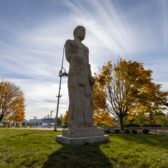
Hercules
The mighty hero of ancient Greece. The Gods tested him with 12 labours. He is seen here after slaying the Nemean lion.
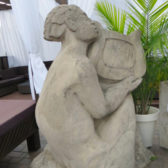
Orpheus
He charmed the creatures of the forest with his wonderful playing of the lyre and his heavenly singing.
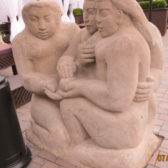
Three Graces
These beauties were judged by Paris and the most beautiful of them received the golden apple.
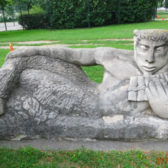
Pan
The elusive god of the forest, half man, half goat, full of fun and games. He invented the reed pipes and filled the woods with their sounds.
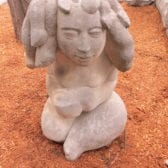
Medusa
One of three gorgons, with hair of snakes, whose glance changed all who looked at her into stone
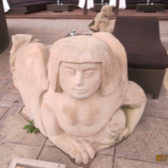
Sphinx
A strange creature with claws of a bird and the body and tail of a lion. This woman would devour passing travelers if they could not answer her riddle right away
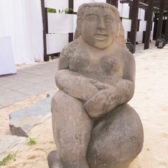
Aphrodite
Goddess of love, also known as Venus, born of the sea she reached shore riding a scallop shell.
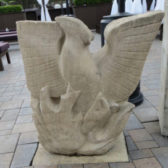
Phoenix
After living in the desert for 500 years, this bird was consumed by fire. It rose anew from its own ashes and is the symbol of eternal life.
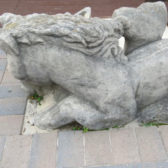
Sea Horse
These creatures appeared on the surface of the Mediterranean as whitecaps. In large groups they could stir up quite a storm if the wind was right.
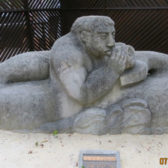
Triton
He ruled the seas and by blowing on his conch shell could either stir up the waves or calm a storm.
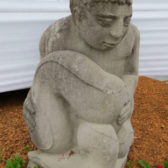
Typhon
Supposed to be a fearsome creature, half man, half snake. This last surviving specimen doesn’t seem so very fierce.
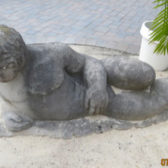
Narcissus
A handsome young man who pined away for the love of his own reflection, finally turning into the flower of the same name.
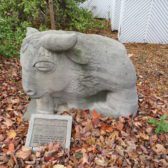
Minotaur
Half bull, half man, he guarded the maze for the king of Crete until vanquished by the Greek prince Theseus.
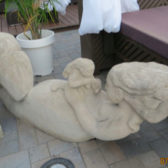
Mermaid
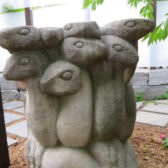
Hydra
A monstrous dragon with nine heads originally – however if one head was cut off, two heads grew in its place. This one has 14 heads so figure how many heads were cut off?
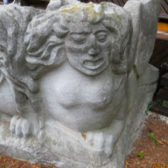
Harpies
These bird women were the embodiment of conscience and tore at the hearts of evil-doers.
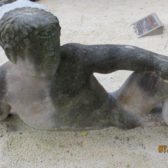
Cyclops
One of the race of giant one-eyed men who herded sheep for a living. They were finally done in by Hercules after a fierce struggle.
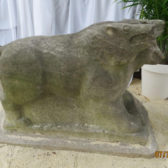
Cerberus
This savage three-headed dog guarded the gates of Hades, to keep good people out and bad people in.
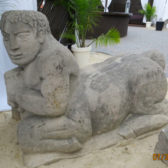
Centaur
One of a jolly race of creatures, half man, half horse, who lived in the forest of ancient Greece and were very hard to catch.
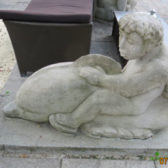
Boy on a Dolphin
Many stories come down from antiquity of children having dolphins for playmates and sailors being helped to shore by dolphins.
Start
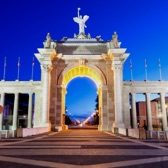
Princes' Gates
The Princes’ Gates, designed by the architectural firm of Chapman & Oxley, were opened in 1927 by H.R.H. Edward, Prince of Wales and his brother, Prince George. The nine pillars on either side of the centre arch of the gates represent the participating provinces of Confederation (Newfoundland joined Confederation in 1949). The figure at the top of the arch, the “Goddess of Winged Victory,” was sculpted by Charles McKechnie and underwent major restoration in 1987. The Princes’ Gates were designated as historically significant under the Ontario Heritage Act later that same year.
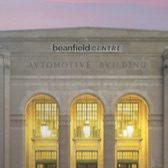
Beanfield Centre
In 1929, Douglas Kertland was chosen over thirty other Toronto competitors for the honour of being named architect for this building. Kertland’s design is a unique blend of Classical and Modern styles. When it was first built, the Automotive Building was used to showcase new car and truck models. During the Second World War it served as a naval facility. In recent years, the building housed a variety of trade and consumers shows, and special events. In 2009, the Automotive Building underwent major renovations and is now a state-of-the-art conference centre renamed Beanfield Centre.
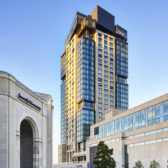
Hotel X Toronto
Opened in 2018, Hotel X provides Toronto visitors with a cutting edge mix of hospitality, sporting and entertainment options. Set amidst lavish gardens and with spectacular lake and city views, Hotel X contains 406 guest rooms and suites, restaurants, a cinematech, retail shopping and a rooftop pool and bar area.
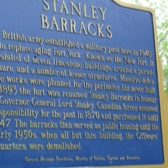
Officers' Quarters, Stanley Barracks
Built in 1841, Stanley Barracks was built to replace Fort York as the Toronto garrison. Stanley Barracks originally consisted of six main buildings around a parade square. Between 1951 and 1953, five of the buildings were demolished, leaving only the Officers’ Quarters. The Officers’ Quarters housed the Marine Museum from 1959 until 1998. In 2018, it will be integrated with Hotel X.
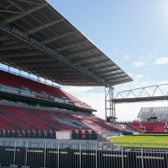
BMO Field
This site has been home to four Grandstands. The first was built in 1879 and replaced by a larger version in 1895. The 1895 Grandstand was destroyed by fire in 1906 and replaced in 1907. That Grandstand was destroyed by fire in 1946 and replaced in 1948. In the 1970s, a sports stadium was added to the south side of the 1948 Grandstand. The Grandstand and Stadium were demolished in 1999. Currently the site, is home to BMO Field, Canada’s first soccer-specific stadum and official home of the Toronto FC and the Toronto Argonauts.
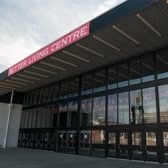
Better Living Centre
In 1962 the Better Living Centre was built on the site of the Manufacturer’s Building which had burned down in 1961. The Better Living Centre is used by a number of various shows and special events.
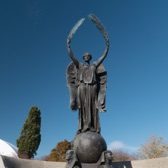
Shrine Monument
On June 12, 1930, the Ancient Arabic Order Nobles of the Mystic Shrine dedicated this bronze monument, the “Peace Memorial,” to commemorate over 100 years of peaceful relations between Canada and the United States. In 1958, the fountain and gardens were added and the statue rededicated to the cause of peace. The statue faces the Niagara River, which forms part of the Canada-United States border.
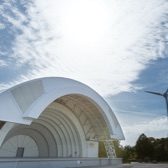
Bandshell
Modeled after the Hollywood Bowl, the Bandshell was built in 1936 at a cost of $47,000. It is still known for it’s acoustic excellence. Many great bands have graced the bandshell stage, including Guy Lombardo and his Royal Canadians, Louis Armstrong, the Scots Guards and the bands of the Royal Marines.
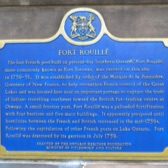
Fort Rouillé
Built by the French in 1750-51, Fort Rouillé was used as a trading post until 1759 when the threat of English invasion forced its destruction by the retreating French. A small cairn was placed on the site in 1878 and nine years later the obelisk that now marks the spot was added. Excavated in 1984 as part of Toronto’s 150th anniversary celebrations, a cement outline of the fort walls gives visitors an idea of the original size and shape of the structure.
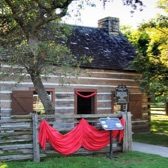
Scadding Cabin
Toronto’s oldest existing home was built in 1794 for John Scadding who accompanied Lieutenant Governor John Graves Simcoe to Upper Canada in 1792. Scadding Cabin was moved to the grounds from the east bank of the Don River in 1879 by the York Pioneer and Historical Society, which is still responsible for its operation. The move was part of the celebrations marking the inauguration of the Toronto Industrial Exhibition (forerunner of the CNE). In 1986, the cabin was designated as historically significant under the Ontario Heritage Act. Scadding Cabin is open to the public during special events (in the summer months).
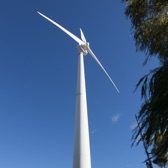
Wind Turbine
Erected in 2002, the Wind Turbine was a joint project between Windshare Cooperative and Toronto Hydro Energy Services Inc.. The $1.4 million dollar Wind Turbine stands 95 meters above the eastern shore of the grounds and produces 1,800-megawatt hours of energy per year, enough electricity to power 250 homes. It is the first urban wind turbine in North America providing green electricity sources that reduce greenhouse gas emissions and improve air quality.
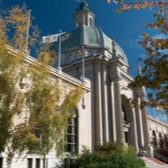
Liberty Grand
This unique, three-sided structure was built in 1926 to house the exhibits of the Ontario Government during each CNE. Constructed in the Beaux-Arts style by the architectural firm of Chapman & Oxley, Liberty Grand (formerly the Ontario Government Building) marks the entrance to the grounds from the Dominion Gate of Exhibition Place. In 1986, the Ontario Government Building was designated as historically significant under the Ontario Heritage Act. The interior was renovated in 2002 by the Liberty Grand Entertainment Group and features three impressive, grand ballrooms.
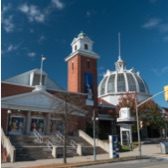
Medieval Times
Originally named the Government Building and later the Arts, Crafts and Hobbies Building, this structure was constructed in 1912 to showcase the exhibits of local and foreign governments. The building was designed by George W. Gouinlock and bears a strong resemblance to the Horticulture Building. Since1993, it has been home to Medieval Times, a dinner theatre featuring medieval jousting.

OVO Athletic Centre
Opened in January 2016, this two-story, 68,000 square-foot facility provides the Toronto Raptors with a state-of-the-art basketball training centre boasting two regulation-sized NBA courts, a large medical area, a full hydrotherapy zone, and an athletic training room.
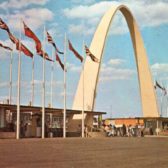
Dufferin Gate
This gateway to Exhibition Place has been rebuilt three times (1895, 1910, and 1959). Before the Princes’ Gates were built, the Dufferin Gate served as the main entrance to the grounds. In 1959, construction of the Gardiner Expressway necessitated the demolition of the 1910 gate, which was replaced with the current parabolic arch.
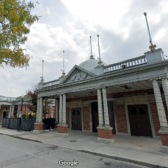
Toronto Event Centre
Originally named the Horticulture Building, this structure was designed by George W. Gouinlock, and built in 1907 to replace the Crystal Palace, which had burned to the ground in 1906. Until recently, the Horticulture Building was used for agricultural, horticultural and floricultural displays. It is currently leased to Toronto Event Centre. The steel and glass dome on this building bears a strong resemblance to that of the nearby Medieval Times Building.
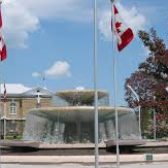
Princess Margaret Fountain
The Gooderham Fountain graced this site from 1911, and was a well-known landmark and meeting place on the grounds. It was named after George H. Gooderham, President of the CNE Association from 1909 to 1911. H.R.H. The Princess Margaret officially opened the current fountain in 1958, which remains a focal point of the western end of the grounds.

Administration Building
This building, formerly called the Press Building, housed the offices of the CNE Association from 1905 to 1957. These offices moved to the Queen Elizabeth Building in 1957 and this building became the headquarters for the media during the annual CNE, when it was renamed the Press Building. Currently, the building is again home to the CNE Association and has restored its original name.
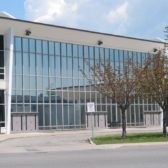
Queen Elizabeth Building
This structure was to have been called the Women’s Building but the name was changed to honor H.M. Queen Elizabeth II. Since the building opened in 1957, it has been used to house administrative offices up until 2014. The structure also houses the Queen Elizabeth Exhibit Hall and Theatre. The Exhibit Hall is available for use throughout the year while the Queen Elizabeth Theatre and the FountainBlu are currently leased.
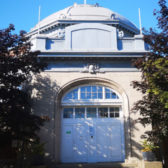
Music Building
Originally named the Railways Building, this structure showcased displays presented by the Grand Trunk, Canadian Northern and Canadian Pacific Railways. It was designed in 1907 by George W. Gouinlock. In 1968, the building was used for music competitions and soon became known as the Music Building. In 1985, the building was designated as historically significant under the Ontario Heritage Act. A major fire in 1987 gutted the building, but it’s exterior has since been restored to its original condition. The Music Building is currently leased to Toronto Fashion Incubator.
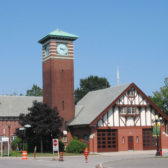
Fire Hall and Police Station
Designed in 1912 by G.W. Gouinlock, this structure houses a detachment of the Toronto Fire Department during the annual CNE. Toronto Police also inhabited the building during the CNE, but since 1992 the police have had a unit stationed in the building on a year-round basis.
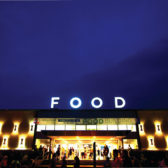
Food Products Building
The original Food Building was constructed in 1921 and was part of a proposed fifty-year plan to re-develop the physical layout of the grounds. Once opened, the Food Building brought the majority of food exhibits together under one roof for the first time. By 1954, an expansion was necessary and the present day structure, the Food Products Building, was constructed on the same site.
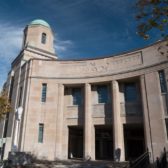
Horse Palace
When built in 1931, the Horse Palace was billed as one of the finest equestrian facilities in Canada. The Art Deco style of this building makes it visually appealing, with it’s copper cupola and the figures of horses rendered in the masonry on the exterior of the structure. From 1942-1946, the Horse Palace served as a barracks for Canadian Army recruits. Today, the Horse Palace is home to the Toronto Police Mounted Unit and the Exhibition Riding Academy.
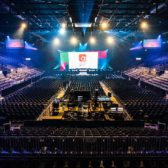
Coca Cola Coliseum
Construction of the Coliseum was a joint effort between the CNE and the Royal Agricultural Winter Fair. When the first phase of construction was completed in 1922, the Coliseum was billed as the largest structure of its kind in North America. During the years 1942-1946, the CNE grounds were closed to the public and the Coliseum was known as #1 Manning Depot, housing recruits for the Royal Canadian Air Force. In 2003, after extensive renovations funded by the Board of Governors of Exhibition Place and the City of Toronto, the new Coliseum reopened as part of Enercare Centre. The Coca Cola Coliseum and its arena are home to the Toronto Marlies as well as a host to numerous shows & events, concerts, hockey games and special events throughout the year.

Enercare Centre
Opened in 1997, the Enercare Centre (formerly the National Trade Centre and the Direct Energy Centre) is the largest trade show facility in Canada and the sixth largest in North America. Offering extraordinary flexibility, the facility’s 1 million square feet can be subdivided into 10 exhibit halls. The facility also boasts 24 meeting rooms, a 100 seat presentation theatre and a 10,000 seat arena.
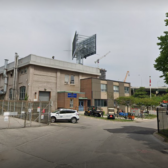
General Services Building
Originally built by Ontario Hydro ca. 1912, this building is now home to the offices of the Operations Division of Exhibition Place and of Records and Archives. The Records & Archives is open to the public Monday through Friday and welcomes visitors by appointment only. To arrange a visit, please call (416) 263-3676 or (416) 263-3659.
Start
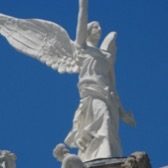
Princes’ Gates – Winged Victory (1927), Artist: Charles D. McKechnie (1865-1935)
This iconic sculpture topping the triumphal arch of the Princes’ Gates was originally constructed of ‘artificial stone’ made from cement. In 1987, it was replaced with a resin copy due to the severe damage and weathering sustained by the original. The Winged Victory holds a laurel wreath, or ‘hero’s crown’, in her uplifted right hand and a single maple in leaf in her left, a symbol of Canadian independence. She is guarded by four sea horses and flanked by figures representing Exhibition Place’s commitment to progress through industry, education, and the arts.
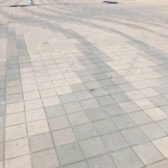
Enercare Centre – Shoreline (1996), Artist: Jerry Clapsaddle (1941-present)
This walkway at the southeast corner of the Enercare Centre consists of 135,000 individually laid paving stones and was commissioned for the newly built National Trade Centre. The best view is from the top of the stairs, looking down and up Princes’ Boulevard. From this vantage point, you can see the expanding and compressing wave made up of six different coloured stones, a metaphor for the lakeshore and the flow of trade on both the lake and through Exhibition Place.
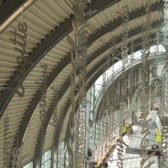
Enercare Centre – Hall of Names (1997), Artist: Micah Lexier (1960-present)
Visible through the windows of the Enercare Galleria, but even more spectacular inside, this work is made up of 1000 laser-cut stainless steel names hanging from the ceiling. Each name was chosen through a ‘call for names’ campaign and represent the people who visit the building. Next time you visit, look up! You may spot your own name there. Micah Lexier’s work can also be seen at Metro Hall and Leslie subway station.
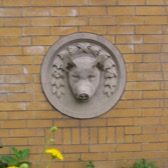
Heritage Court – Livestock Roundels (1926), Artist: unknown
Made of cast stone, these five roundels and two decorative plaques were originally located on the outside of the Coliseum complex, and were moved to their current location when it was partially demolished between 1995 and 1997. Another livestock roundel from the Coliseum complex – as well as three rams heads keystones – are located in the north-east hallway of the Enercare Centre.
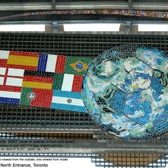
BMO Field – Arc of Nations (2007) & Benches (2007), Artist: Stephen Cruise (1949-present)
This two-sided glass mosaic, located over the north entrance to BMO Field, is made up of over 200 tiny FIFA flags representing the international sport of soccer. This artwork, along with 14 granite benches, was commissioned by Exhibition Place to mark the opening of the soccer stadium. The benches are scattered around the perimeters of the soccer venue and feature the artist’s designs (based on the sporting and architectural history of Exhibition Place) laser cut into the granite. An additional 4 were commissioned by Exhibition Place and are installed on the north and south sides of the Beanfield Centre.
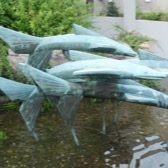
Food Building (east side) – Fish (1954), Artist: Jean Horne (1914-2007)
Commissioned for the newly constructed Food Building, this group of five flying fish was originally part of a system of pools and waterfalls on the building’s exterior. Jean Horne was a Toronto artist and the first female artist in Canada to use steel welding in sculpture as a part of her body of work. She only created a few public works – most of her work was private – so enjoy this rare experience!
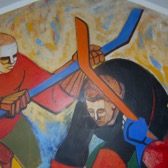
BMO Field (west side) – Face Off (1961), Artist: Ronald Satok (1932-2018)
A hockey painting in a soccer stadium? Some might question this juxtaposition but the painting Face Off is not just about hockey – it’s the epitome of so many sports. Two teams or two players facing off in the heat of competition – this moment is captured in Ron Satok’s painting inside BMO Field Gate 5 entrance. It was originally located inside the main entrance of the Hockey and Sports Hall of Fame at Exhibition Place, demolished in 2006. Satok also created the glass and tile mosaic Painter’s Eye, located in the north entrance of the Better Living Centre.
Queen Elizabeth Theatre (south façade) – Mother & Children (1957), Artist: Frances Loring (1887-1968)
Originally from the Idaho, Frances Loring moved to Toronto in 1912 and shared a studio with another female artist, Florence Wyle. This relief sculpture was created for the newly constructed women’s building, later named the Queen Elizabeth Building. It was cast in polystyrene, a relatively new plastic material at the time which proved to be more permanent and weather resistant than bronze.
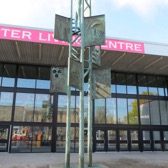
Better Living Centre (north entrance) – Man above Matter (1963), Artist: Arthur Donald Price (1918-2008)
This 25-foot cast bronze sculpture originally stood in front of the Coliseum’s entrance and was moved to the Better Living Centre in 1997. A committee of City of Toronto and CNE officials and the architects of the new Coliseum façade selected Price’s design from seven submissions. It consists of 300 separate mold pieces and features banners with objects representing the activities held within the Coliseum, including a horse, cob of corn, and cowboy hat.
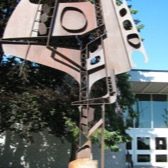
Better Living Centre (west side) – 83 Sculpture (1968), Artist: Ronald Baird (1940-present)
This steel sculpture was built on site by sculptor Ron Baird who was commissioned by the House of Seagram for the 1968 CNE. The 26-foot high sculpture was originally built in front of the Art Gallery and at a later date relocated to the west side of the Better Living Centre. It is titled 83 after Seagram’s 83 Canadian Whiskey, the most popular brand of whiskey in 1968.
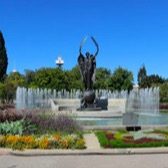
Rose Garden – Shriners’ Peace Memorial (1930), Artist: Charles Keck (1875-1951)
The Shriners’ Peace Memorial was dedicated in June 1930 during a convention of the Ancient Arabic Order of the Nobles of the Mystic Shrine (Shriners) to commemorate nearly a century of peaceful relations between Canada and the United States. Located on the site where it was believed American troops landed during the War of 1812, the winged figure, the Goddess of Peace, stands with her arms upraised and holds aloft two olive branches, facing the mouth of the Niagara River.



